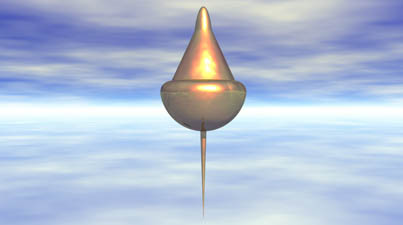
That Sharp Pointed Object
(Revised 31 Jan 2010)


Another
one
of the enigmas of Mesopotamia is the Din.Gir.
The name Din.Gir is Sumerian meaning “righteous ones of the
bright pointed objects”. The Sumerians were referring to the
Anunnaki, the pantheon of their gods. They used this two part symbol to
designate the
Anunnaki collectively. When
looking at how the Sumerians wrote this symbol it is not apparent from
this two dimensional drawing that it represents a three
dimensional object. It's only when you look at the solar
winged disk
that
you see it as the three dimensional object that it is. This disk has
been presented in a variety of styles from the mechanical
to one much more bird like. There is another translation of Din.Gir
as "The Righteous Ones of the Blazing Rockets". What is the
word
in Sumerian which means "Blazing rockets"?
This is a Sitchin mistranslation and unfortunately has been carried
over to other web sites as well. The myths of the sun god both
Mesopotamian and Egyptian have the sun god traveling across the sky in
a
boat, the vehicle of choice. What follows is speculation on the Gir -
what seems to be a capsule of sorts - that sharp pointed object.
These associations with the Gir are multiple and involve several interrelated concepts that at first do seem unrelated. As a two part logogram, the Din. half seems to represent something burning and the second part, the .Gir, a capsule for lack of a better word. This Din.Gir is another representation for the winged solar disk of Sumeria. Just as this symbol appears mechanical so do the earliest representations of the winged disk. Later the Assyrians and the Persians would depict the winged disk as carrying their national god as if in a winged vehicle. This idea of the gods riding a vehicle stems from the oral traditions of the Paleolithic down to the time of the Greco-Roman world. Even in some of the medieval paintings the artist has snuck in this idea of a celestial piloting a flaming vehicle which has the modern interpretation of a UFO. Legends have a life of their own and point out the difficulties of understanding their true meaning through a cultural veil. This is why I prefer to reference what the Sumerians have written because simply the Sumerian texts are the touchstone for all these legends. The modern problem of interpretation is in understanding that from the winged disk other ideas have emerged through a splintering off from the original whole. The Din.Gir is a good example. As I have stated earlier on this site the winged disk is a seraphic transport by which the celestials (read Anunnaki) arrived to this planet. This epical event is ground zero for all that came after and can be found in this enigmatic symbol the Din.Gir. On the page The Serpent I go into more detail on the connection of the winged disk as seraphim and the connection of the serpent, it's relation to a vehicle and the soul. But here we will remain with the Gir and how it relates to the Anunnaki. Of all modern academians who have looked at these symbols none have really described them as they actually are. Alternative speculation gets closer but no cigar. When the symbol for the serpent is present the deity bird is never far from view. They are and forever will be inexorably tied to one another. The root of the problem is this: the serpent and the deity bird are the same thing. They are not different but they are different representations of the same thing. And this is why it is difficult to separate out these varied meanings and associations. I can tell you after years of combing through an untold number of web sites on all things related to this core subject none have even suggested that the serpent and bird are one and the same. (Actually, the Asian Ying Yang principle comes the closest as in the dragon and the Phoenix). And I do not wonder on this state of affairs. It is only because of what the Urantia Book has to say about epical events, what the Sumerians have written and all else about this subject(s) on the net that it finally dawned on me as to how all this relates and how it has been enculturated around the world. The biggest help is of course in knowing about the Andites, their genesis, why they are the source of the legends, how they carried these legends and beliefs with them around the world and from where the power of religion and the state came from.
I am going to leave the Din. part, the burning part, to the page The Serpent. The Gir part is the capsule otherwise known as the pointed object. However the pointed part is the seraphim. What the Gir may be in this connection is a container which is enseraphimed. In this symbol the Gir has a pyramid shape. The capstone which sit atop the Egyptian pillar - the obelisk - is a pyramid as is the "first ground" of Egyptian lore. This first ground is represented by the Benben stone also a pyramid. If you have read the page Omphalos and Baetyl Stone you would understand why this stone became known as the House of God. Thus the connection of the gods and an association to a pyramid shape. As an aside to this discussion the Bennu bird stands atop a pyramid capstone on the Papyrus of Nakht (http://www.touregypt.net/featurestories/heliopolis.htm).
These associations with the Gir are multiple and involve several interrelated concepts that at first do seem unrelated. As a two part logogram, the Din. half seems to represent something burning and the second part, the .Gir, a capsule for lack of a better word. This Din.Gir is another representation for the winged solar disk of Sumeria. Just as this symbol appears mechanical so do the earliest representations of the winged disk. Later the Assyrians and the Persians would depict the winged disk as carrying their national god as if in a winged vehicle. This idea of the gods riding a vehicle stems from the oral traditions of the Paleolithic down to the time of the Greco-Roman world. Even in some of the medieval paintings the artist has snuck in this idea of a celestial piloting a flaming vehicle which has the modern interpretation of a UFO. Legends have a life of their own and point out the difficulties of understanding their true meaning through a cultural veil. This is why I prefer to reference what the Sumerians have written because simply the Sumerian texts are the touchstone for all these legends. The modern problem of interpretation is in understanding that from the winged disk other ideas have emerged through a splintering off from the original whole. The Din.Gir is a good example. As I have stated earlier on this site the winged disk is a seraphic transport by which the celestials (read Anunnaki) arrived to this planet. This epical event is ground zero for all that came after and can be found in this enigmatic symbol the Din.Gir. On the page The Serpent I go into more detail on the connection of the winged disk as seraphim and the connection of the serpent, it's relation to a vehicle and the soul. But here we will remain with the Gir and how it relates to the Anunnaki. Of all modern academians who have looked at these symbols none have really described them as they actually are. Alternative speculation gets closer but no cigar. When the symbol for the serpent is present the deity bird is never far from view. They are and forever will be inexorably tied to one another. The root of the problem is this: the serpent and the deity bird are the same thing. They are not different but they are different representations of the same thing. And this is why it is difficult to separate out these varied meanings and associations. I can tell you after years of combing through an untold number of web sites on all things related to this core subject none have even suggested that the serpent and bird are one and the same. (Actually, the Asian Ying Yang principle comes the closest as in the dragon and the Phoenix). And I do not wonder on this state of affairs. It is only because of what the Urantia Book has to say about epical events, what the Sumerians have written and all else about this subject(s) on the net that it finally dawned on me as to how all this relates and how it has been enculturated around the world. The biggest help is of course in knowing about the Andites, their genesis, why they are the source of the legends, how they carried these legends and beliefs with them around the world and from where the power of religion and the state came from.
I am going to leave the Din. part, the burning part, to the page The Serpent. The Gir part is the capsule otherwise known as the pointed object. However the pointed part is the seraphim. What the Gir may be in this connection is a container which is enseraphimed. In this symbol the Gir has a pyramid shape. The capstone which sit atop the Egyptian pillar - the obelisk - is a pyramid as is the "first ground" of Egyptian lore. This first ground is represented by the Benben stone also a pyramid. If you have read the page Omphalos and Baetyl Stone you would understand why this stone became known as the House of God. Thus the connection of the gods and an association to a pyramid shape. As an aside to this discussion the Bennu bird stands atop a pyramid capstone on the Papyrus of Nakht (http://www.touregypt.net/featurestories/heliopolis.htm).
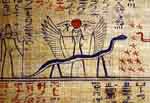 The
Egyptians had several
sun gods to
represent the rising sun,
the sun high in the sky and the setting sun.
The morning sun, Atum, rode a winged serpent at sun rise and was one of
the oldest of the Egyptian gods in the cosmology at Heliopolis which is
Greek for On (Coptic) or Iunu the original Egyptian name. The original
name means pillar. It is
interesting that a god needed this sacred boat to travel across the
heavens. Later the boat became a chariot drawn by winged horses. The
Egyptian connections with the various elements of the solar winged disk
are deep and complex. What is important is that due to the antiquity
from which the Egyptians speak helps with a more unadulterated view of
what all this may mean.
The
Egyptians had several
sun gods to
represent the rising sun,
the sun high in the sky and the setting sun.
The morning sun, Atum, rode a winged serpent at sun rise and was one of
the oldest of the Egyptian gods in the cosmology at Heliopolis which is
Greek for On (Coptic) or Iunu the original Egyptian name. The original
name means pillar. It is
interesting that a god needed this sacred boat to travel across the
heavens. Later the boat became a chariot drawn by winged horses. The
Egyptian connections with the various elements of the solar winged disk
are deep and complex. What is important is that due to the antiquity
from which the Egyptians speak helps with a more unadulterated view of
what all this may mean.For more information on the Egyptian connection go to: http://home.eol.ca/~cumulus/Obelisk/index.htm

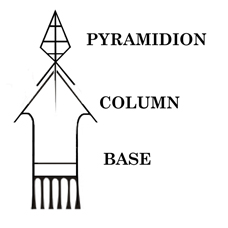
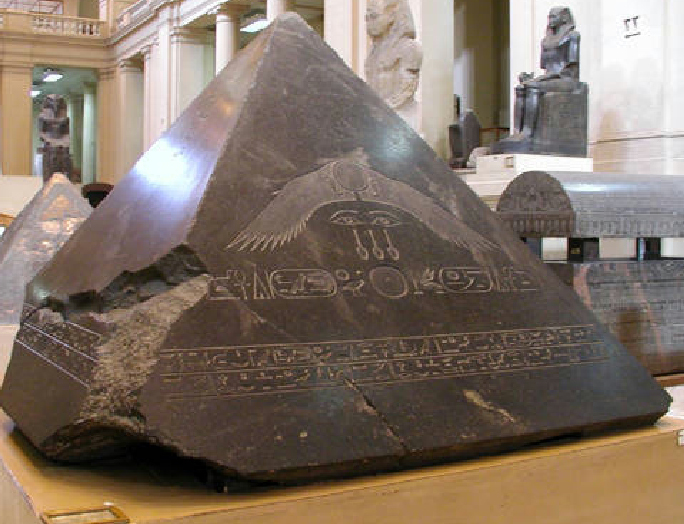
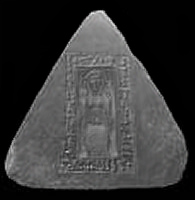

 The
obelisk may be
the Egyptian representation of the Sumerian Din.Gir. It has
the three parts of cap, shaft and base. But
it is the capstone, the pyramidion, which is the
most interesting
part. It was traditional to encase this cap stone in gold metal or
a mixture of
gold and silver called electrum. Electrum is a
naturally occurring gold in Egypt and is sometimes called Egyptian Red
Gold. It
is generally accepted that the Benben stone at Heliopolis was a
meteorite
and that it was conical in shape. This
pyramidion is also known in another form as the Benben stone. This
stone represented
the first ground in the shape of the pyramid. It is the
spot
that the god Atum (Egypt's first god) brought everything into
existence. It arose
from the waters of earth. It is the
Primeval
Mound, the "let dry land appear.
And it was so." In this
context it
relates directly to the Sumerian and Babylonian concept of the
primitive hill. This
pyramidion became the residence of Atum the sun god who later became
assimilated with Ra as Ra-Atum. Lastly this Benben stone represented
the star-soul of the departed pharaoh. If the Benben housed the spirit
of Atum (also Ra) then it may
explain why the solar winged disk is inscribed on capstones
and why beings, supposedly a god/gods, are shown in a doorway on the
gray capstones above.
As for as the Benben being spirit indwelt this seems to extend in Egypt
to
Atum/Ra alone. My speculations on this is that Atum being the oldest
god may carry associations that are the closest to Sumerian. That would
include the Benben with a connection to the winged solar disk, the soul
residing within the Benben and the Benben being a representation
of the hub, the pointy object, of the winged disk both as a
carrier of souls but
also
as a capsule.
The
obelisk may be
the Egyptian representation of the Sumerian Din.Gir. It has
the three parts of cap, shaft and base. But
it is the capstone, the pyramidion, which is the
most interesting
part. It was traditional to encase this cap stone in gold metal or
a mixture of
gold and silver called electrum. Electrum is a
naturally occurring gold in Egypt and is sometimes called Egyptian Red
Gold. It
is generally accepted that the Benben stone at Heliopolis was a
meteorite
and that it was conical in shape. This
pyramidion is also known in another form as the Benben stone. This
stone represented
the first ground in the shape of the pyramid. It is the
spot
that the god Atum (Egypt's first god) brought everything into
existence. It arose
from the waters of earth. It is the
Primeval
Mound, the "let dry land appear.
And it was so." In this
context it
relates directly to the Sumerian and Babylonian concept of the
primitive hill. This
pyramidion became the residence of Atum the sun god who later became
assimilated with Ra as Ra-Atum. Lastly this Benben stone represented
the star-soul of the departed pharaoh. If the Benben housed the spirit
of Atum (also Ra) then it may
explain why the solar winged disk is inscribed on capstones
and why beings, supposedly a god/gods, are shown in a doorway on the
gray capstones above.
As for as the Benben being spirit indwelt this seems to extend in Egypt
to
Atum/Ra alone. My speculations on this is that Atum being the oldest
god may carry associations that are the closest to Sumerian. That would
include the Benben with a connection to the winged solar disk, the soul
residing within the Benben and the Benben being a representation
of the hub, the pointy object, of the winged disk both as a
carrier of souls but
also
as a capsule. 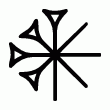 There
is another ideogram also called the dingir
which precedes the name of the gods. It is called a determinative to
indicate divinity of the name following it. Some web sites claim that
the dingir
is the Sumerian name for god. This is not so, it is the logogram by
which the name that follows it is said to be divine. In fact the dingir
is silent much like an apostrophe is silent. The Sumerians never called
"those who from heaven came" as gods. Such an appellation is Greek. By
the way demons are also considered divine and use the dingir
as well.
There
is another ideogram also called the dingir
which precedes the name of the gods. It is called a determinative to
indicate divinity of the name following it. Some web sites claim that
the dingir
is the Sumerian name for god. This is not so, it is the logogram by
which the name that follows it is said to be divine. In fact the dingir
is silent much like an apostrophe is silent. The Sumerians never called
"those who from heaven came" as gods. Such an appellation is Greek. By
the way demons are also considered divine and use the dingir
as well.The
name Anunnaki means "Those who from Heaven came"
Their logogram means “righteous ones of the bright pointed objects”
Both of these statements are true.
Their logogram means “righteous ones of the bright pointed objects”
Both of these statements are true.

The Tree of Life and the Ancients